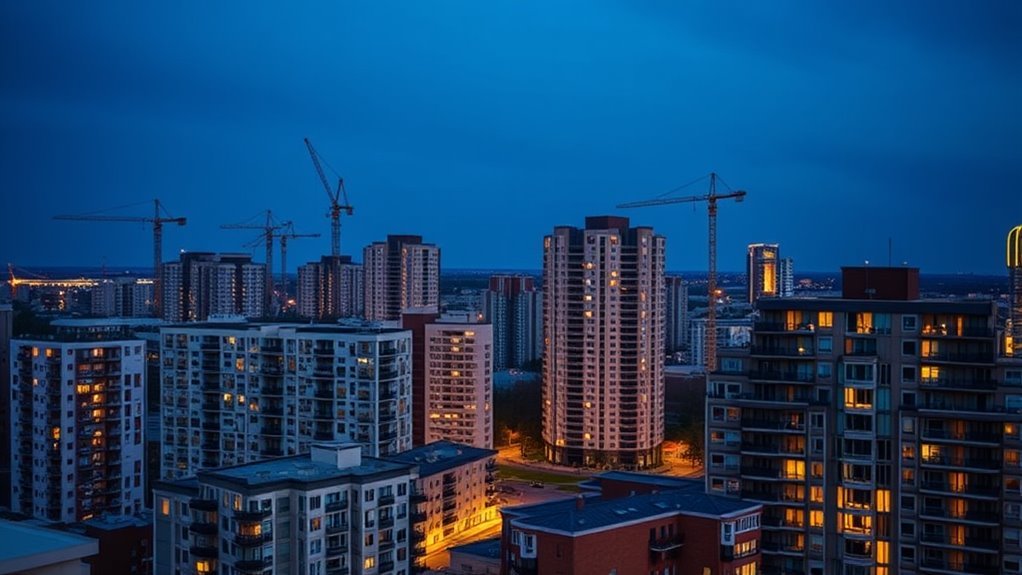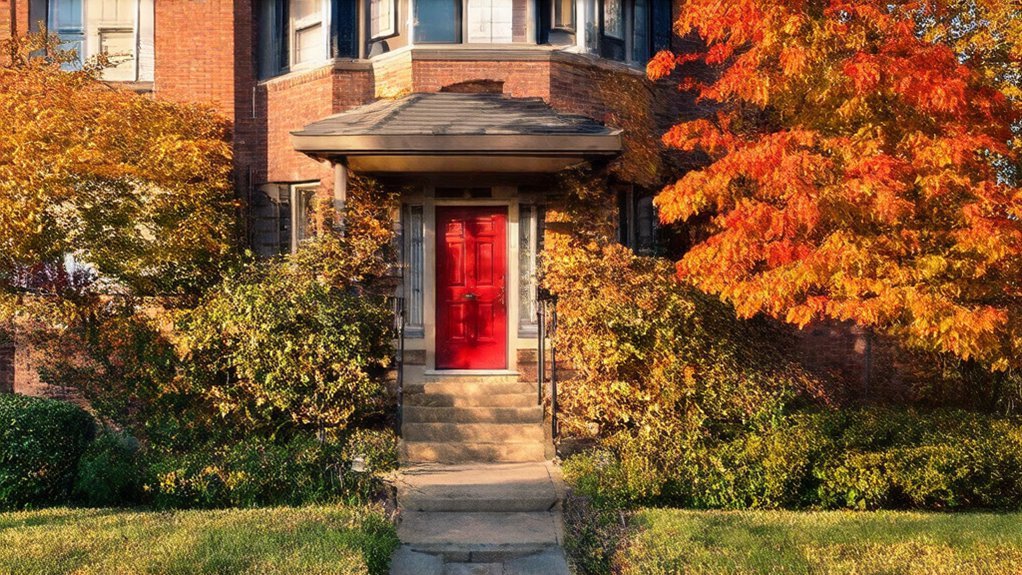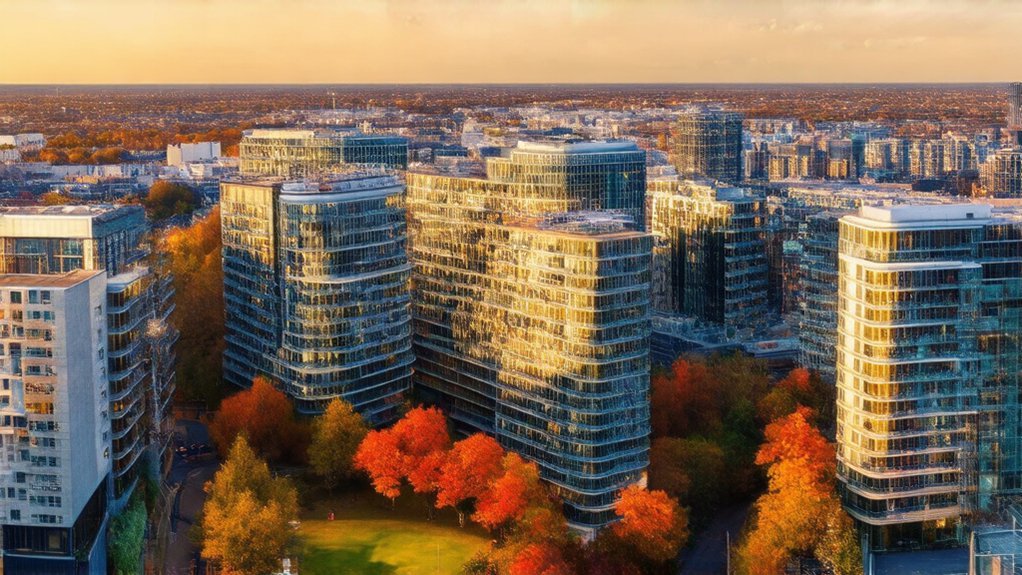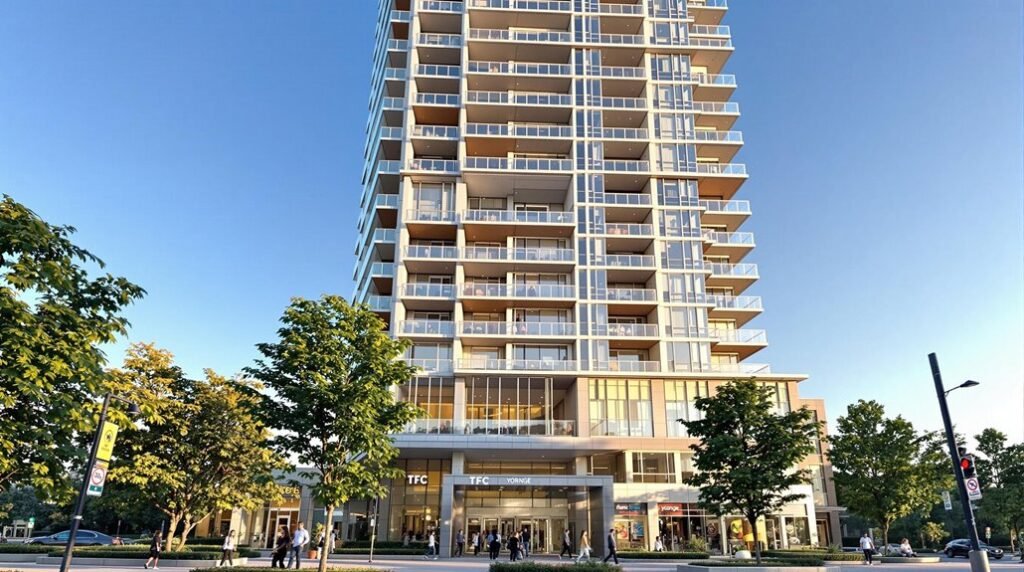Toronto’s rental market will see significant changes through 2025 due to strong population growth and immigration. You’ll find rental prices climbing 6% to 8% in key areas while one-bedroom rates offer some relief at $2,452. The city plans to add 7,000 new rental homes including 5,600 purpose-built units to address the housing shortage. Lower interest rates near 4.25% will make mortgages more affordable for investors. The market shows robust rental demand with a low 1.6% vacancy rate in North York. These trends point to solid investment potential in Toronto’s rental sector. The full market picture reveals even more promising opportunities ahead.
Key Takeaways
- Rental prices in Toronto are projected to increase 6-8% in key areas, while current one-bedroom units average $2,452 monthly.
- Population growth, driven by 98% immigration, will intensify rental demand as Toronto approaches 3 million residents by 2025.
- Condo rental market shows strong growth with 25.2% increase in apartment rentals and 51.3% surge in listings.
- Low vacancy rates (1.6% in North York) and limited housing supply will maintain competitive rental market conditions.
- Expected interest rate reductions in 2025 will improve investment conditions and increase rental property acquisition opportunities.
Market Forces Shaping Rental Demand

Multiple market forces are converging to shape Toronto’s rental demand heading into 2025. You’ll see significant population growth driving the rental market forward. Strong immigration policies continue to attract newcomers who typically seek rental accommodations when they first arrive. The influx of international students and professionals adds substantial pressure to rental demand. Average one-bedroom rents decreased to $2,452, providing some relief for tenants.
The interest rate environment plays a vital role in shaping rental patterns. While rates might stabilize or decrease in 2025, many potential homebuyers remain in the rental market due to affordability concerns. The anticipated Bank of Canada cuts will influence rental market dynamics. You’ll notice that even with improved borrowing conditions, rental demand stays robust as newcomers and young professionals choose to rent. The market’s vacancy rate sits at a 35-year low of 1.5%, intensifying competition among renters.
Recent market activity shows impressive growth with these key indicators:
- Condo apartment rentals increased by 25.2% in Q2 2024 compared to Q2 2023
- Rental listings jumped by 51.3% in the same period
- Q1 2024 saw 12,541 condo lease transactions
- Year-over-year lease transactions grew by 19.7%
Development trends are reshaping rental opportunities across Toronto. You’ll find new high-rise condos and mixed-use projects adding to the rental inventory.
Infrastructure improvements make suburban areas more attractive to renters seeking affordable options. These emerging neighborhoods offer fresh rental opportunities with integrated amenities.
The combination of population growth, economic factors, and development patterns suggests Toronto’s rental demand will remain strong through 2025. You can expect continued market activity as new developments come online and demographic trends persist.
Pricing Outlook and Investment Returns

The intense rental demand directly impacts Toronto’s pricing landscape and investment potential for 2025. You’ll find rental prices climbing 6% to 8% in downtown Toronto and transit-connected areas. This increase stems from immigration growth and limited supply in high-demand locations.
The housing market shows distinct trends across different segments:
- Condo Market
- Prices will decline 1% year-over-year by Q4 2025
- New developments create potential oversupply
- Rental yields remain strong despite price softening
- General Housing
- Average home prices will grow 3% to 5%
- GTA aggregate prices reach $1,225,770
- Single-family homes increase 7% to $1,523,466
- Suburban Markets
- Higher appreciation rates than city core
- Growing demand due to affordability
- Infrastructure improvements boost accessibility
Your investment returns will benefit from strong rental cash flows. Condo rentals offer attractive yields due to high demand. With federal targets set to welcome over 500,000 immigrants annually, rental demand will remain robust. Current market conditions offer less bidding pressure for investors. Properties under under $1 million continue to generate intense competition and multiple offers. You can expect positive cash flow even with lower purchase prices.
The anticipated lower interest rates in 2025 will make mortgages more affordable.
Regional differences present varied opportunities:
- Downtown: High rental demand
- Suburbs: Better price appreciation
- Transit-connected areas: Premium rental rates
The market won’t see the dramatic price increases of the early 2020s. Instead you’ll find stable growth patterns emerging by mid-2025.
This creates a balanced environment for both rental income and long-term appreciation potential.
Supply and Development Pipeline

Despite ambitious development plans, Toronto faces a critical rental housing shortage heading into 2025, with limited purpose-built rental investments since the 1990s creating a substantial supply gap. High interest rates and rising construction costs have markedly slowed new residential development. The city’s growing population and unaffordable home ownership market continue to drive rental demand. New rental projects must include at least 20% affordable units to address housing accessibility. A prime example is the newly approved 250 Dundas St. W development featuring a 57-storey tower with 719 rental units.
The city’s HousingTO Action Plan aims to create 40,000 affordable rental units by 2030 to combat the severe shortage.
To address this crisis, Toronto has launched an aggressive development pipeline with specific targets. You’ll see major changes through these key initiatives:
- The city will directly build 7,000 rental homes using its own resources, including 5,600 purpose-built units and 1,400 affordable homes.
- Private developers like Dream plan to construct 2,000-3,000 purpose-built rental units by 2026.
- A second phase will add 13,000 new rental homes, with 10,400 purpose-built and 2,600 affordable units.
- All construction must begin by the end of 2026 to qualify for new incentives.
The city’s commitment includes a $461.1 million investment to jumpstart development. You’ll find new incentives designed to attract builders, including indefinite development charge deferrals and a 15% municipal tax reduction for eligible projects. Developers must dedicate 20% of units as affordable housing to qualify for these benefits.
Success depends heavily on government partnerships. The city seeks $1 billion from provincial sources and $7.3 billion in federal financing to support the 20,000-unit goal. Additional funding of $225.3 million each from provincial and federal governments will help create affordable rental units.
Interest Rate Impact Analysis
Interest rates remain central to Toronto’s real estate landscape, shaping both development prospects and market dynamics. You’ll notice considerable shifts from early 2024’s high rates to mid-year reductions that brought the Bank of Canada’s rate to 4.25%. Market competition has decreased as fewer first-time buyers participate in the market. This change has created new opportunities for buyers and investors in the market. Government incentives introduced for first-time homebuyers have helped offset some affordability concerns.
The impact of interest rates on Toronto’s real estate market can be broken down into three key areas:
- Borrowing costs and affordability
- You’ll find monthly mortgage payments have become more manageable
- Lower rates have brought previously sidelined buyers back to the market
- Affordability challenges persist due to high housing prices
- Investment opportunities
- You can now secure more favorable mortgage terms
- Lower rates have increased investor confidence
- Rental market investments have become more attractive
Popular areas like East York neighborhoods are seeing increased investor activity.
3. Market outlook for 2025
- You can expect rates to remain stable with possible moderate reductions
- The market will likely see continued investor activity
- Rental demand will stay strong due to Toronto’s growing population
These interest rate changes don’t affect all buyers equally. While luxury buyers with substantial cash reserves weren’t greatly impacted, first-time homebuyers have seen meaningful improvements in their purchasing power.
You’ll want to watch for further rate adjustments as they’ll influence both property values and investment returns. The Bank of Canada’s careful balance between economic growth and inflation control will continue to shape market conditions throughout 2025.
Population Growth and Migration

Dramatic population shifts continue reshaping Toronto’s real estate landscape, with the city on track to reach 3 million residents by 2025.
You’ll find Toronto leading the way as North America’s fastest-growing city, adding over 221,500 new residents between July 2022 and 2023. Immigration drives this remarkable growth, accounting for 98% of Canada’s population expansion in 2023.
This surge in population creates significant impacts on the real estate market. You can expect increased competition for housing as newcomers settle in the city. The federal government’s plan to welcome 395,000 permanent residents by 2025 will intensify demand for both rental and purchase properties. Recent trends show non-Canadian citizens represent 17.2% of Toronto’s total population. The government aims to maintain sustainable growth by capping temporary residents at 5% of the overall population by 2026.
Key population trends affecting Toronto’s real estate market:
- Nearly half of Toronto’s new residents come from immigration
- Temporary residents will make up 40% of permanent admissions by 2025
- Skilled workers fill vital gaps in healthcare, construction, and technology sectors
- The metropolitan area shows consistent growth patterns across all regions
You’ll notice these demographic shifts spreading beyond the city core. Suburban areas like Hamilton, Oshawa, and Barrie attract newcomers seeking affordable housing options. North York’s rental vacancy rate of 1.6% reflects the intense demand for housing in Toronto’s suburban regions.
This migration pattern creates new opportunities in previously overlooked markets. The government’s plan to address housing needs includes building 670,000 new units by 2027.
As Toronto’s population continues expanding, you’ll see increased pressure on housing availability. This growth particularly affects areas near transit lines and employment centers.
The city’s development plans focus on accommodating this influx while maintaining livability standards.
Conclusion
You’ll see Toronto’s rental market continue to tighten through 2025. Population growth and limited new supply will drive rents higher across the GTA. Interest rates and construction costs remain key factors affecting development. Expect 5-7% annual rent increases in most neighborhoods. Your best investment opportunities exist in transit-oriented developments and purpose-built rentals. Monitor immigration policies and housing starts for early market signals.


















